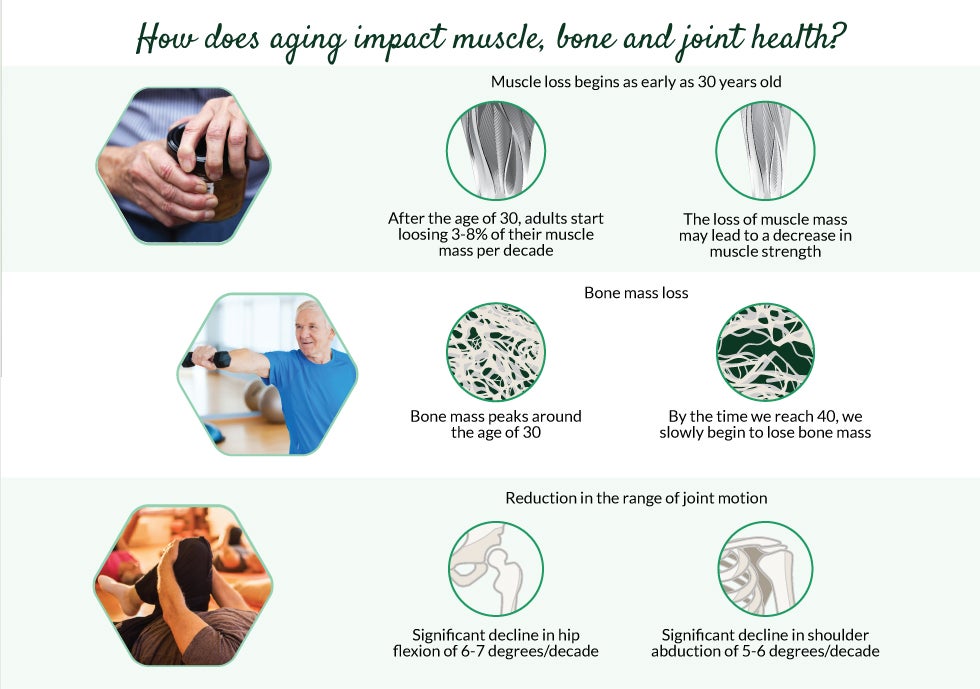Aging and impact on mobility?
Mobility is the joy of moving freely and easily. Healthy muscles, bones and joints allow us to perform all types of movements - from everyday tasks to enjoying our favorite hobbies.
Some of the first visible signs of aging may be changes to posture and gait, as well as fatigue and general weakness doing everyday tasks. People may notice an impact on mobility when engaging in activities such as walking. Aging affects muscle mass and strength, bone density, and can make joints stiffer and less flexible due to reduction of cartilage thickness.
As we age, muscles, bones and joints undergo physiological changes that affect mobility and which can ultimately impact our independence. Daily physical activity combined with weight management and a healthy balanced diet that includes proper intake of protein, vitamin D and C, and calcium can support the health of your muscle, bones and joints and keep you moving. Embrace the allies of positive aging.

1. English KL, Paddon-Jones D. Protecting muscle mass and function in older adults during bed rest. Current Opinion in Clinical Nutrition and Metabolic Care. 2010;13(1):34-39. (Muscle loss Reference)
Importance of muscle health: The age-related loss of muscle may decrease mobility. Loss of muscle mass can begin as early as 30 years and it can become more prominent from the age of 50 onwards. The rate of muscle loss is influenced by the amount of regular physical activity people do throughout their lives. An injury or temporary illness can also affect the amount of skeletal muscle mass. Daily consumption of protein contributes to healthy muscle mass.

Importance of bone health: Bone health is important at any age. The reduction in bone density that is common in older age makes bones weaker which in turn may lead to increased risk of fractures. Good nutrition including the necessary amounts of vitamins and minerals like Calcium and Vitamin D combined with exercise can help maintain good bone health during later stages of life.

Importance of joint health: Joints become more vulnerable to damages as the cartilage that lines them becomes thinner and the lubricating (synovial) fluid is reduced as we age. This means that joint surfaces aren’t able to slide as smoothly over one another, causing discomfort. Joints become stiffer as the ligaments and tendons become more rigid and muscle tone and bone strength is reduced. These changes make physical tasks more and more difficult.


Key tips to maintain mobility
A decrease in mobility can have a significant impact on a person’s wellbeing especially when it interferes with one’s ability to enjoy favorite hobbies, social outings and to remain independent. Key ways of tackling the issue include:
- Good nutrition – consume the daily recommended amount of protein - essential for maintenance of muscle mass and strength. Studies2 show almost half of older adults currently do not consume enough protein. Ensure proper intake of micronutrients such as vitamins (e.g. C and D) and minerals (e.g. calcium, magnesium, potassium, zinc).
- Regular physical activity – including weight / resistance training to help maintain muscle mass
- Weight management – maintain the optimal weight for your height and age
To learn more, read The Importance of Protein and The Allies for Healthy Aging
1. English KL, Paddon-Jones D. Protecting muscle mass and function in older adults during bed rest. Current Opinion in Clinical Nutrition and Metabolic Care. 2010;13(1):34-39. (Muscle loss Reference)
2. Hartz, S. C. (1992) The WSS study population. In: Nutrition in the Elderly: The Boston Nutritional Status Survey (Hartz, S. C., Russell, R. M. & Rosenberg, J. H., eds.), London, Smith-Gordon, pp. 17–25.